1. Spinal cord injuries with an ASIA classification at 48 h of A to D
2. Brain injuries with a Glasgow Coma Scale (GCS) at 48 h of ≤12 (i.e. Graded as moderate or severe)
3. Fatalities (incl. spinal cord, traumatic brain, and cardiac-related fatalities)
The incidence of rugby injuries to the head and neck region, which include minor maxillofacial injuries, differs somewhat depending on the age of players and the level of competition, but such injuries are quite prevalent, second only to injuries to the lower limbs (Kaplan et al. 2008; Brooks et al. 2005; Best et al. 2005; Fuller et al. 2008; Schick et al. 2008; Collins et al. 2008). However, the incidence of catastrophic head and/or neck trauma is rare in comparison to other injuries. Although catastrophic head and/or neck trauma is rare, such trauma cannot be ignored given the prognostic significance of sequelae such as paralysis and the impact of that trauma on surrounding tissues and structures. The current study analyzes the CIs reported to the Japan Rugby Football Union (JRFU) in order to parlay the results of that analysis into safety programs for rugby.
5.2 Current Realities of Head and Neck Trauma in Rugby in Japan
Trauma of the head and neck in rugby is rare in comparison to other injuries such as concussions, bumps on the head, cuts on the head or face, and nasal fractures. However, a CI can occur in the form of an acute subdural hematoma, acute epidural hematoma, traumatic subarachnoid hemorrhage, brain contusions, or a cervical spinal cord injury. According to previous studies, most head and neck trauma occurs as a result of tackling (Collins et al. 2008; MacManus and Cross 2004). The cause of the injury is described as being largely related to tackling skill (Mcintosh et al. 2010; Silver 2002)
In Japan, individuals suffering CIs and matches are most numerous in high school. Unfortunately, the impression that is given is that CIs often occur. Thus, safety measures to prevent CIs are targeted specifically at high school students. Watanabe et al. examined the number of high school and university students who suffered a CI per 100,000 players in Japan from 2008 to 2011, and they found that university students suffered more CIs. A similar trend was noted in a study overseas. Quarrie et al. stated that the number of CIs peaked at ages 22–25 (Quarrie et al. 2002). Focused safety measures are needed for high school students as well as university students (Table 5.2, Figs. 5.1 and 5.2).
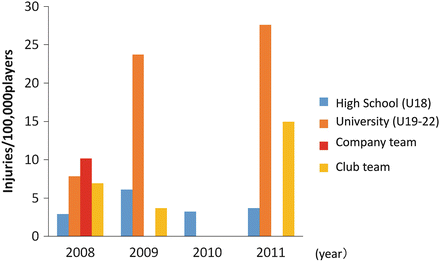
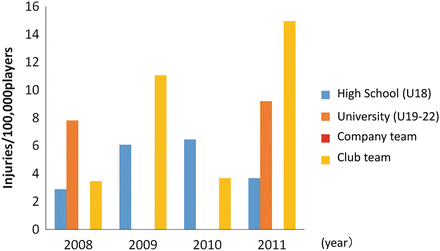
Table 5.2
Total number of matches in 2011. Rugby union game in 2011
Grade | Total |
|---|---|
High school (U18) | 1,195 |
University (U19-22) | 822 |
Club team | 376 |

Fig. 5.1
Incidence of cervical spinal cord injuries in Japan (injuries/100,000 players)

Fig. 5.2
Incidence of severe head trauma in Japan (injuries/100,000 players)
Mcintosh et al. analyzed the tackling techniques of elite players and players ages 15–20, and they found that younger players often made a “passive shoulder tackle” whereby they stopped moving forward and absorbed the brunt of their opponent’s energy (Mcintosh et al. 2010). As players improved, they started making an “active shoulder tackle” whereby they oriented their body towards their opponent while moving forward. Mcintosh et al. noted that younger individuals had less developed tackling techniques.
A study examined catastrophic cervical spinal cord injuries suffered by players from ages 12 to 19 (U19) in Scotland, Wales, Ireland, and England, and it noted that tackles were most often responsible for those injuries, followed by scrums (Maclean and Hutchison 2011). In Japan, catastrophic head and/or neck trauma is, when categorized for all age groups, very often related to tackling. The next most prevalent cause is a scrum in other regions, but in Japan it is a ruck. A ruck is a tight scramble for a ball on the ground (Table 5.3).
Table 5.3
Study of cervical spinal cord injuries by the IRB
Phases of play | 2008–2011 | JRFU (%) |
|---|---|---|
Scrum engagement | 11 | 18.2 |
Scrum collapse on engagement | 8 | 12.5 |
Scrum collapse not on engagement | 3 | 33.3 |
Tackler | 21 | 23.8 |
Ball carrier | 10 | 40.0 |
Ruck | 17 | 47.1 |
Maul | 3 | 33.3 |
Collision | 5 | 0.0 |
Unknown | 3 | 0.0 |
Total | 81 | 27.2 |
Thus, instruction in safety measures, which includes teaching correct tackling techniques, is key to preventing head and neck trauma in rugby, regardless of whether the injury is mild or catastrophic (27).
5.3 Causes of Injury
5.3.1 Causes of Injury Related to Tackles
Head and neck trauma in rugby is most often caused by tackling (MacManus and Cross 2004; Silver 2002; Quarrie et al. 2002; Maclean and Hutchison 2011). A key factor is an individual player’s tackling skill (Yamada et al. 2004; John et al. 2008). Of the incidents of catastrophic head and/or neck trauma reported to the JRFU, close to 60 % are due to “head-first contact” (Yamada 2011). There are several forms of head-first contact, though the one that most often causes head and/or neck trauma is when a tackler (a player tackling an opponent) makes a tackle with his head down while not looking at the ball carrier (the player with the ball), as shown in Figs. 5.3 and 5.4. When the tackler’s head collides with his opponent, the tackler’s head moves in the direction the ball carrier was moving. The tackler’s head is violently struck by the ball carrier’s knees or the front of his/her torso in what is known as a “head-spinning tackle” (Yamada et al. 2004).
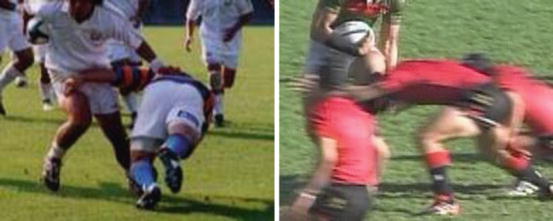
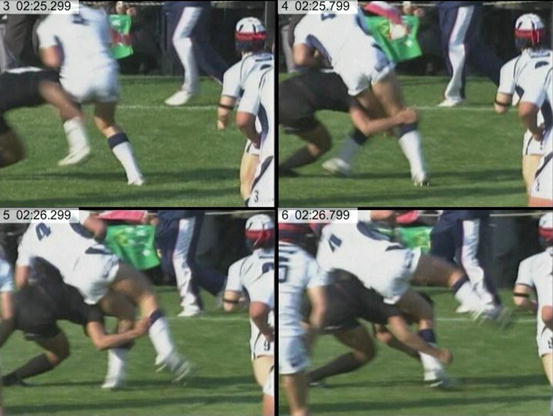

Fig. 5.3
A head-down tackle made with the head down while not looking at one’s opponent

Fig. 5.4
A head-spinning tackle (the head is incorrectly positioned)
In other tackling situations, there is a high risk of head and neck trauma when there are two or more tacklers tackling a single opponent at the same time. This situation puts both the ball carrier and the tacklers at risk. When the tacklers make impact, one of the tacklers may be tackling the ball carrier above his shoulders. Part of the ball carrier’s body often comes into contact with the tackler’s head and neck region (Fig. 5.5) (Mcintosh et al. 2010; Yamada 2008). When the head is lowered in the event of a passive tackle, as mentioned earlier, head trauma often results.
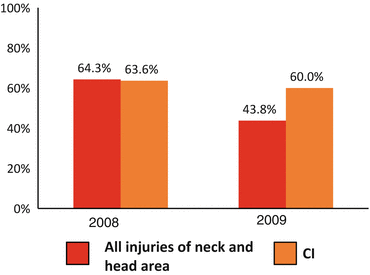

Fig. 5.5
Proportion of catastrophic injuries in Japan due to a blow to the head
There are few detailed domestic studies of how ball carriers are injured. There are two possibilities which are both restricted by current game rules. One is a high tackle where the ball carrier is tackled above his shoulders (Fig. 5.11a), and the other is a spear tackle where the player with the ball is driven head-first into the group (Fig. 5.11b) (Fuller et al. 2010). If a high school student lacks skill at being tackled, his head may strike the ground, resulting in a concussion.
Stay updated, free articles. Join our Telegram channel

Full access? Get Clinical Tree








